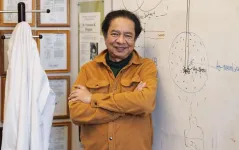(Press-News.org) For organs to develop, grow and regenerate, cells must proliferate. But when that process goes awry, leading to uncontrolled cell growth, cancer can emerge.
New CU Boulder research, published in the journal Science Advances, offers unprecedented insight into how an enigmatic enzyme, known as CDK7, drives this complex process. The research shows that novel cancer drugs designed to inhibit CDK7 can, within minutes, shut down gene expression pathways that drive cell proliferation in dozens of different kinds of tissues.
“This work addresses a long-standing mystery surrounding an enzyme critical for regulating the cell cycle and cell proliferation,” said senior author Dylan Taatjes, a professor in the Department of Biochemistry. “Not only does it help us understand a fundamental biological process important for development, it also has broad therapeutic applications.”
Understanding an enigma
For decades, cancer researchers and pharmaceutical companies have eyed cyclin dependent kinase (CDK7) with interest due to its role as a “master regulator” of cell proliferation. CDK7 does this in two ways: It switches on other enzymes known as kinases, including CDKs 1, 2, 4 and 6, which kick-start cells to divide and multiply. It also regulates gene expression in ways that, until now, have remained unclear. The new study found that it controls the function of proteins called transcription factors, which influence when and how genes are expressed.
While CDK7 is critical for normal development, certain cancers, including aggressive and hard-to-treat “triple negative” breast cancers, hijack this process to drive runaway growth.
In recent years, several companies have developed CDK7 inhibitors that, in clinical trials, have worked to slow tumor growth. But it’s not entirely clear how they do this. The drugs have serious side effects, and in clinical trials they have fallen short of killing tumors entirely.
To better understand how this master regulator works, Taatjes teamed up with Robin Dowell, a professor of Molecular, Cellular and Developmental Biology; Taylor Jones, then a graduate student in biochemistry; and colleagues at CU Boulder’s BioFrontiers Institute.
The researchers applied a CDK7-inhibitor provided by Syros Pharmaceuticals and already used in clinical trials to cancerous human tissue cells. Then they used sophisticated computational techniques to watch, essentially in real time, what happened next.
They found that within 30 minutes, a core set of transcription factors that turn on genes that prompt cells to proliferate was uniformly shut down. In other experiments, this same set of transcription factors was found to be consistently on in all proliferating cell lines tested. This included 79 cell lines, mostly from human cancers, representing 27 different tissue types.
This points, for the first time, to a universal mechanism by which CDK7 controls human cell proliferation, said Taatjes.
“We found that the second that you inhibit CDK7, all of these core transcription factors shut off at once, stopping proliferation in its tracks,” said Taatjes.
Smothering cancer promoters
The research team points to one particular protein that, like a blanket thrown on a patch of growing flames, seems to smother all those transcription factors at once when CDK7 is inhibited. The protein, retinoblastoma protein 1 (RB1), is well known as a key tumor suppression gene whose normal function is often compromised by cancer. But efforts to target RB1 with medication have been largely unsuccessful.
“This study reveals that CDK7 controls RB1 function—a finding that could open doors to new ways of therapeutically targeting RB1,” said Taatjes.
Meanwhile, CDK7’s other role—of kick-starting enzymes that nudge cells to divide and multiply—is also blocked by the inhibitor they tested, but this occurs more slowly and is not dependent on the core set of transcription factors.
Taken together, these findings suggest that it may be possible to develop new therapies that disable some of the enzyme’s disease-causing functions rapidly, while leaving its beneficial roles intact.
“Instead of, essentially, using a sledgehammer to shut down all CDK7 activities, it could be that you could shut down just one branch of its activities that is more important for tumor proliferation while minimally disrupting normal cell function,” said Taatjes.
The result: a more precise cancer killer that inflicts less collateral damage.
END
Study unravels mystery of cancer-fueling enzyme—could lead to new therapies
Cancer drugs designed to inhibit CDK7 shut down pathways that drive proliferation within minutes
2025-03-25
ELSE PRESS RELEASES FROM THIS DATE:
Lupus-related antibody shows promise in enhancing cancer treatment efficacy
2025-03-25
New Haven, Conn. — Yale scientists have discovered a promising way to trigger immune responses against certain tumors, using a lupus-related antibody that can slip, undetected, into “cold” tumors and flip on an immune response that has been turned off by cancer. The research, published in Science Signaling on March 25, offers new findings that could help improve therapies for glioblastoma and other aggressive cancers that are difficult to treat.
“It turns out when this antibody gets into the cell’s cytoplasm [the liquid material inside the cell, excluding the nucleus] and it binds ...
BESSY II: Magnetic ‘microflowers’ enhance local magnetic fields
2025-03-25
A flower-shaped structure only a few micrometres in size made of a nickel-iron alloy can concentrate and locally enhance magnetic fields. The size of the effect can be controlled by varying the geometry and number of 'petals'. This magnetic metamaterial developed by Dr Anna Palau's group at the Institut de Ciencia de Materials de Barcelona (ICMAB) in collaboration with her partners of the CHIST-ERA MetaMagIC project, has now been studied at BESSY II in collaboration with Dr Sergio Valencia. Such a device can be used to increase the sensitivity of magnetic sensors, to reduce the energy required for creating local magnetic fields, but also, at ...
New study may help predict cardiometabolic disease risk and personalize prevention strategies
2025-03-25
A new study explores how epigenetic markers—chemical modifications that influence gene activity—can help predict the risk of developing cardiometabolic diseases and guide personalized prevention strategies. The findings are particularly significant as the prevalence of major cardiometabolic risk factors such as hypertension, diabetes, and obesity continues to rise despite advancements in healthcare and treatment. This trend highlights the need for better early detection and intervention.
The study is titled “Poly-epigenetic scores for cardiometabolic risk factors interact with demographic factors and health behaviors in older US Adults” and is published in the journal ...
The Frontiers of Knowledge Award goes to Avelino Corma, John Hartwig and Helmut Schwarz for their founding work on the catalysts that are enabling a more efficient, sustainable chemistry
2025-03-25
The BBVA Foundation Frontiers of Knowledge Award in Basic Sciences has gone in this seventeenth edition to Avelino Corma (Institute of Chemical Technology, Universitat Politècnica de València-CSIC, Spain), John F. Hartwig (University of California, Berkeley, United States) and Helmut Schwarz (Technical University of Berlin, Germany) for fundamental advances in the catalysis field, in the words of the committee, that have made it possible to “control and accelerate chemical ...
New software finds aging cells that contribute to disease and health risks
2025-03-25
For human health, prematurely aging cells are a big problem. When a cell ages and stops growing, its function changes, which can cause or worsen cardiovascular disease, Alzheimer’s disease and other chronic diseases. But these cells are also like needles in a haystack, difficult to identify by traditional scientific measures.
To find these problematic cells, a University of Illinois Chicago doctoral student has developed a powerful new software platform called SenePy. In a paper for Nature Communications, Mark ...
UTA inventors recognized worldwide for innovations
2025-03-25
Inventors from The University of Texas at Arlington have once again been a vital part of the University of Texas System’s recognition as one of the world’s leading innovation centers. According to the prestigious National Academy of Inventors (NAI), UT System ranks No. 6 on its Top 100 Worldwide Universities Granted U.S. Utility Patents list for 2024. UTA contributed 23 patents—an increase of 15% over 2023—to UT System’s total of 234 last year.
“Being a top-ranking member of the Top 100 Worldwide ...
Ocean eddies – the food trucks of the sea
2025-03-25
Mesoscale eddies, oceanic swirling currents with typical horizontal scales of 10-100 kilometres in diameter, are ubiquitous features of the global ocean and play a vital role in marine ecosystems. Eddies, which form in biologically productive coastal upwelling regions, are important vehicles for the transport of carbon and nutrients. These eddies trap water masses and migrate into the open ocean, where productivity is comparatively low. As such, they have a significant influence on the nutrient and carbon cycles within the ocean.
For decades, marine scientists have sought to understand in detail how coastal waters are transported offshore and how this process affects productivity in ...
UNM researchers find live hantavirus is carried in more than 30 New Mexico small mammal species
2025-03-25
Ever since 1993, when a deadly disease outbreak in the Four Corners first revealed the presence of hantavirus in North America, New Mexicans have been warned to be on the lookout for deer mice, which harbor the microbe and can spread it through their droppings.
A few human cases, usually presenting with severe cardiopulmonary symptoms, typically occur in New Mexico each year – almost all in the northwestern quadrant of the state – and even with advanced treatment about 35 percent of patients die.
But now, University of New Mexico researchers have found ...
How a mother’s connection during pregnancy shapes future relationships
2025-03-25
A recent study conducted by Nora Medina, PhD, a postdoctoral researcher of family and community medicine at Thomas Jefferson University, along with colleagues from the University of Chicago, highlights the importance of the emotional bond that a mother establishes with her child during pregnancy.
The study team followed 160 young, low-income, racially diverse mothers from pregnancy until their children were two and a half years old. Mothers who felt more connected to their babies during pregnancy were more likely to have a healthier, positive relationship with their children ...
Spreading and clotting of platelets are regulated by separate pathways
2025-03-25
When skin is cut or damaged, tiny cell fragments circulating in the blood, called platelets, arrive at the injury and spread out to stop the blood from leaking out. Once enough layers of platelets accumulate, like stacks of sandbags against a flood, a blood clot is formed, trapping red blood cells. When the break occurs in a blood vessel, the clot contracts to facilitate smooth blood flow through the vessels.
Until recently, researchers believed that platelet spreading and clot contraction were controlled ...
LAST 30 PRESS RELEASES:
Can community awareness campaigns in low-resource areas improve early diagnosis of colorectal cancer?
Stardust study resets how life’s atoms spread through space
Practical education: Clinical scenario-based program development
The impact of family dynamics on eating behaviour – how going home for Christmas can change how you eat
Tracing the quick synthesis of an industrially important catalyst
New software sheds light on cancer’s hidden genetic networks
UT Health San Antonio awarded $3 million in CPRIT grants to bolster cancer research and prevention efforts in South Texas
Third symposium spotlights global challenge of new contaminants in China’s fight against pollution
From straw to soil harmony: International team reveals how biochar supercharges carbon-smart farming
Myeloma: How AI is redrawing the map of cancer care
Manhattan E. Charurat, Ph.D., MHS invested as the Homer and Martha Gudelsky Distinguished Professor in Medicine at the University of Maryland School of Medicine
Insilico Medicine’s Pharma.AI Q4 Winter Launch Recap: Revolutionizing drug discovery with cutting-edge AI innovations, accelerating the path to pharmaceutical superintelligence
Nanoplastics have diet-dependent impacts on digestive system health
Brain neuron death occurs throughout life and increases with age, a natural human protein drug may halt neuron death in Alzheimer’s disease
SPIE and CLP announce the recipients of the 2025 Advanced Photonics Young Innovator Award
Lessons from the Caldor Fire’s Christmas Valley ‘Miracle’
Ant societies rose by trading individual protection for collective power
Research reveals how ancient viral DNA shapes early embryonic development
A molecular gatekeeper that controls protein synthesis
New ‘cloaking device’ concept to shield sensitive tech from magnetic fields
Researchers show impact of mountain building and climate change on alpine biodiversity
Study models the transition from Neanderthals to modern humans in Europe
University of Phoenix College of Doctoral Studies releases white paper on AI-driven skilling to reduce burnout and restore worker autonomy
AIs fail at the game of visual “telephone”
The levers for a sustainable food system
Potential changes in US homelessness by ending federal support for housing first programs
Vulnerability of large language models to prompt injection when providing medical advice
Researchers develop new system for high-energy-density, long-life, multi-electron transfer bromine-based flow batteries
Ending federal support for housing first programs could increase U.S. homelessness by 5% in one year, new JAMA study finds
New research uncovers molecular ‘safety switch’ shielding cancers from immune attack
[Press-News.org] Study unravels mystery of cancer-fueling enzyme—could lead to new therapiesCancer drugs designed to inhibit CDK7 shut down pathways that drive proliferation within minutes


